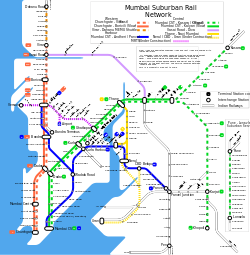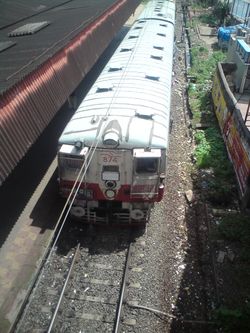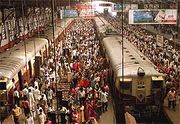Mumbai Suburban Railway
| Mumbai Suburban Railway | |
|---|---|
 |
|
| Info | |
| Locale | Mumbai, India |
| Number of lines | Western, Central and Harbour |
| Daily ridership | 6.94 Million |
| Annual ridership | 2.54 Billion |
| Operation | |
| Began operation | 1857 |
| Operator(s) | Western Railways and Central Railways |
| Technical | |
| System length | 427.5 kilometres (265.6 mi) |
| Track gauge | 1676 mm (5 ft 6 in) (broad gauge) |
| Average speed | 50 km/h (31 mph) |
| Top speed | 100 km/h (62 mph) |
The Mumbai Suburban Railway (Marathi: मुंबई उपनगरीय रेल्वे) system, part of the public transport system of Mumbai, is provided for by the state-run Indian Railways' two zonal Western Railways and Central Railways. The system carries more than 6.9 million commuters on a daily basis and constitutes more than half of the total daily passenger capacity of the Indian Railways itself. It has one of the highest passenger densities of any urban railway system in the world. The trains plying on its routes are commonly referred to as local trains or simply as locals by the general populace.
The Mumbai Suburban Railway , as well as Indian Railways, are an offshoot of the first railway to be built by the British in India in April 1853, and was also the oldest railway system in Asia. The first train ran between Mumbai and Thane, a distance of 34 km. The Bombay Railway History Group[1] has been striving to document railway heritage along this line.
Due to the geographical spread of the population and location of business areas, the rail network is the principal mode of mass transport in Mumbai. As Mumbai's population swelled from a heavy inflow of migrants in recent decades, frequent overcrowding has become a serious issue, and numerous safety concerns have been raised over the years. A metro system and a monorail system are under construction in Mumbai to ease the travelling conditions in the Suburban network.
Contents |
Facilities
Spread over 464 route kilometres, The Suburban Railway system operates on 1500 V DC / 25000 V AC (Virar-Borivali & Kasara - Titwala) power supply from overhead catenary lines. The suburban services are run by electric multiple units (EMUs). 191 rakes (train sets) of 9-car & 12-car composition are utilised to run 2342 train services, carrying 6.94 million passengers per day.
Zones and corridors

Two zonal Railways, the Western Railway (WR) and the Central Railway (CR), operate the Mumbai Suburban Railway system. At present, the fast corridors on Central Railway as well as Western Railway are shared for long distance (main line) and freight trains.
Western line
Two corridors (one local and the other through) on Western Railway run northwards from Churchgate terminus parallel to the west coast up to Dahanu Road (120 km). These corridors are popularly referred to as 'Western Line' by the locals mainly because it is operated and owned by the Western Railways. Electric Multiple Units (EMUs) ply between Churchgate and Virar (64 km), while Mainline Electrical Multiple Units (MEMUs) service the section beyond Virar till Dahanu Road (60 km). MEMUs also operate between Dahanu Road and Panvel via a branch line from Vasai Road. There are EMU carsheds at Mumbai Central and Kandivali. A repair shop for EMUs is situated at Mahalaxmi. Western railway's EMU fleet consists of EMUs running on DC (1.5 kV) power as well as those running as dual-current i.e. AC (25 kV) and DC (1.5 KV) power. EMUs are 9 car, 12 car or 15 car formations and are differentiated as slow and fast locals. Slow trains halt at all stations, while fast ones halt at important stations only and are preferable over longer distances. Trains usually start from and terminate at important stations. Abbreviations used for these train sources/destinations are as follows (in alphabetical order):
| Abbreviation | Station name |
|---|---|
| A | Andheri |
| B | Bandra |
| BC | Mumbai Central |
| BO | Borivali |
| BY | Bhayandar |
| BS | Vasai Road |
| C | Churchgate |
| D | Dadar |
| DR | Dahanu Road |
| G | Goregaon |
| M | Malad |
| V | Virar |
Stations on Western line
(Names in bold indicate that the station is a fast train stop.)
Within Mumbai: Churchgate, Marine Lines, Charni Road, Grant Road, Mumbai Central, Mahalaxmi, Lower Parel, Elphinstone Road, Dadar, Matunga Road, Mahim Junction, Bandra, Khar Road, Santacruz, Vile Parle, Andheri, Jogeshwari, Goregaon, Malad, Kandivali, Borivali, Dahisar
Outside Mumbai: Mira Road, Bhayandar, Naigaon, Vasai Road, Nala Sopara, Virar, Vaitarna, Saphale, Kelve Road, Palghar, Umroli, Boisar, Vangaon, Dahanu Road
Churchgate station is the Terminus station at the South End of Mumbai City. In Mumbai, Western Railway (WR) Suburban trains use this station as terminus. Long distance trains and goods trains do not use this station.
Above list of stations is mentioned from South end going towards North suburban areas falling on WR corridor.
Due to South - North corridor of Mumbai suburban railway, the suburban areas are generally classified into East side and West side. E.g. Bandra (East) & Bandra (West), Andheri (East) & Andheri (West) etc.
A new station between Goregaon and Jogeshwari, namely Oshiwara, will be functional soon.
Central line
The Central Line in Mumbai consists of 3 major corridors, which bifurcate as they run into suburban satellite towns. Two corridors (one local and other through) on Central Railway run from Chhatrapati Shivaji Terminus (CST) to Kalyan (54 km), from where it bifurcates into two lines — one running up to Kasara (67 km) in the north-east and the other running up to Khopoli (61 km) in the south-east. These two corridors constitute the 'Main' Line. The Central main line shares two stations with the Western line at Parel and Dadar. They consist of a fleet of DC as well as dual-powered EMUs. The major car sheds on this line are at Kurla and Kalwa. There are fast and slow locals here for suburban service. Slow locals halt at every station, while fast locals halts vary between Byculla, Dadar, Kurla, Ghatkopar, Vikhroli, Bhandup, Mulund, Thane, Dombivali and Kalyan. All services plying beyond Kalyan run slow.

Trains usually start from and terminate at important stations. Abbreviations used for these train sources/destinations are as follows (in alphabetical order):
| Abbreviation | Station name |
|---|---|
| A | Ambernath |
| AN | Asangaon |
| BL | Badlapur |
| C | Kurla |
| D | Dadar |
| DI | Dombivali |
| G | Ghatkopar |
| K | Kalyan |
| KP | Khopoli |
| N | Kasara |
| S | Karjat |
| ST | Chhatrapati Shivaji Terminus |
| T | Thane |
| TL | Titwala |
Stations on Central (Main) line
(Names in bold indicate that the station is a fast train stop.)
Within Mumbai: Chhatrapati Shivaji Terminus , Masjid Bunder, Sandhurst Road, Byculla, Chinchpokli, Currey Road, Parel, Dadar, Matunga, Sion, Kurla, Vidyavihar, Ghatkopar, Vikhroli, Kanjurmarg, Bhandup, Nahur, Mulund
Outside Mumbai: Thane, Kalwa, Mumbra, Diwa, Kopar, Dombivli, Thakurli, Kalyan
- Branch line 1 : Kalyan, Vitthalwadi, Ulhasnagar, Ambarnath, Badlapur, Vangani, Shelu, Neral, Bhivpuri Road, Karjat, Palasdari, Kelavli, Dolavli, Lowjee, Khopoli
- Branch line 2: Kalyan, Shahad, Ambivli, Titwala, Khadavli, Vasind, Asangaon, Atgaon, Khardi, Kasara
- Branch line 3: Vasai Road, Juchandra, Kaman Road, Kharbav, Bhiwandi, Kopar, Dativali, Nilaje, Taloja, Navade Road, Kalamboli, Panvel
Harbour line
The Harbour line is part of the Central Railway, and runs a train corridor from Chhatrapati Shivaji Terminus (CST) to Andheri, Thane and Panvel. All harbour line services operate as slow services. The line operates from two separate platforms at Chhatrapati Shivaji Terminus (CST), and the tracks cross over the main line at Sandhurst Road, to head towards stations along Mumbai's eastern dock area. A branch line from Wadala Road joins the Western Railway Line at Mahim and continues towards Andheri. The harbour line shares a common station at Kurla with the main line, where it turns east towards Navi Mumbai. The Harbour line further bifurcates at Vashi into two lines — one rejoins the main lines at Thane, while the other continues to Panvel. A large section of the harbour line is elevated.
Abbreviations used for these train sources/destinations are as follows (in alphabetical order):
| Abbreviation | Station name |
|---|---|
| AD | Andheri |
| B | Bandra |
| CH | Kurla |
| CM | Chembur |
| M | Mankhurd |
| T | Thane |
| VA | Vashi |
| NU | Nerul |
| BR | Belapur |
| PL | Panvel |
| VD | Wadala Road |
| ST | Chhatrapati Shivaji Terminus |
Stations on Harbour Line
Within Mumbai: Chhatrapati Shivaji Terminus, Masjid Bunder, Sandhurst Road, Dockyard Road, Reay Road, Cotton Green, Sewri, Wadala, Guru Tegh Bahadur Nagar, Chunabhatti, Kurla, Tilak Nagar, Chembur, Govandi, Mankhurd
Within Navi Mumbai: Vashi, Sanpada, Juinagar, Nerul, Seawoods-Darave, CBD Belapur, Kharghar, Mansarovar, Khandeshwar,Panvel
- Branch line 1: Wadala, King's Circle, Mahim, Bandra, Khar Road, Santacruz, Vile Parle, Andheri
- Branch line 2: Vashi, Sanpada, Turbhe, Kopar Khairane, Ghansoli, Rabale, Airoli, Thane
- Branch line 3: Panvel, Khandeshwar, Mansarovar, Kharghar, CBD Belapur, Seawoods-Darave, Nerul, Juinagar, Turbhe, Kopar Khairane, Ghansoli, Rabale, Airoli, Thane
Rakes
A bulk of the current fleet of both the Western and Central railways features old rakes which are capable of a maximum speed of 85 km/h in regular service. Most of these rakes are built by Jessop (Kolkata) and ICF (Perambur). The recently introduced AC/DC rakes (more modern motors in the existing carriage designs) are capable of 100 km/h under low traffic conditions. The actual average speed of the rakes on the slow lines is about 35 km/h, while rakes on fast lines average about 45–50 km/h on a typical run.
On November 12, 2007, 1st new technology rake of 174 new technology rakes with upgraded facilities was inducted into the fleet of the Western Railways under the MUTP project. The coaches are built of stainless steel, and have non-cushioned seats, emergency fluorescent lights, bigger windows with polycarbonate lookout glass, better suspension systems and a novel roof mounted forced ventilation system, station indicators in all coaches, GPS based Public information system in all coaches. These rakes have been procured under the project at a total cost of Rs 1,900 crore (Rs 19 billion) (USD 431.0 million).
As on May 2010, 84 out of 247 (12 coach train) new trains has been delivered to Mumbai Suburban Railway.[2] Total cost of this project is ![]() 5,300 crore (US$ 1.2 billion) [3]
5,300 crore (US$ 1.2 billion) [3]
Mumbai Railway Vikas Corporation (MRVC)
To enable the Mumbai Suburban Railway to meet the demands of the ever-growing passenger traffic, the federal Government of India's Ministry of Railways and the state Government of Maharashtra have jointly envisioned the constitution of a separate corporate entity to operate the system.
The Mumbai Railway Vikas Corporation Ltd (MRVC Ltd), a public sector unit of the Government of India under the Ministry of Railways, was incorporated under the (Indian) Companies Act, 1956 on July 12, 1999, with an equity capital of Rs 25 crores to implement the rail component of an integrated rail-cum-road urban transport project, called Mumbai Urban Transport Project (MUTP). The cost of the rail component of the project is to be shared equally by Ministry of Railways and Government of Maharashtra.
Current Projects of MRVC status as on January 2010
1) Kurla - Thane 5th & 6th Line - to be used for outstation trains and goods trains.
2) Thane - Diva 5th & 6th Line - to be used for Local E.M.U. services.
Safety issues
Overcrowding
Due to its extensive reach across the Mumbai Metropolitan Region, and its intensive use by the local urban population, the Mumbai Suburban Railway suffers from some of the most severe overcrowding in the world.[4] Over 4,500 passengers are packed into a 9-car rake during peak hours, as against the rated carrying capacity of 1,700.[4] This has resulted in what is known as Super-Dense Crush Load of 14 to 16 standing passengers per square meter of floor space. Trains on the suburban line are on average more than 4 minutes apart, contributing to the problem of overcrowding. The impending introduction of new higher speed rakes may help address the issue.
Tourists
It has been advised for safety concerns for tourists to avoid the trains during weekdays, or at least during the morning and evening peak hours. Avoid travelling from north to south between 8 am and 11 am in the morning and from south to north between 6 pm and 9 pm at night. The best way to enjoy the trains is on Sundays when they are relatively empty. However, watch out for Sundays when work is done on the tracks, as it could mean that trains are still crowded on a Sunday. During the work day, beware of getting on the express trains or 'fast trains' as they are called denoted on stations by 'F', especially the trains to Virar.
Fatalities
More than 3,500 people die on the Mumbai suburban railway tracks annually due to unsafe riding on trains or trespassing on railway tracks or as a result of suicide attempts. This is believed to be the highest number of fatalities per year on any urban or suburban railway system. Most of the deaths are of passengers crossing the tracks on foot, instead of using the footbridges provided for going from one platform to another, and are hit by passing trains. Some passengers die when they sit on train roofs to avoid the crowds and are electrocuted by the overhead electric wires, or hang from doors and window bars. To reduce the risk of such fatalities, automatic doors will be installed on all rakes by 2016 along with longer platforms and more frequent trains.
Central and Western Railway was forced to release under the Right to Information Act that at least 20,706 people have died in the last five years; an average of 10 each day. The request was filed by Mumbai activist Chetan Kothari.
According to The Times of UK, Mumbai's local railway network was one of the deadliest in the world: a record 17 people died every weekday on the city's suburban railway network in 2008.[5] Most deaths were people being run over while trespassing on the tracks. The next biggest cause of death was of passengers who fell (or were pushed) from carriages that travel at 64km/h (40mph), are often dangerously full. Another 41 people perished after being bludgeoned by trackside poles while hanging out of overcrowded trains. Twenty-one were electrocuted by power cables when they sat on the roof.
Western Railway has pledged that its trains will stop running if "even a single person" is seen travelling on the roof. “We know that halting a train during peak hours will result in a lot of chaos. However, we cannot let people travel this way as they will surely lose their lives,” a railway spokesman told The Times of India.
Terrorist attacks
The Mumbai Suburban Railway has suffered 8 blasts and around 368 people are believed to have died as a result.
- 14 March 2003 - A bomb went off in a train in Mulund killing 10
- 11 July 2006 - A series of seven bombs went off in trains killing 207
- 26 November 2008 - Chhatrapati Shivaji Terminus was also attacked during the The 2008 Mumbai Attacks killing at least 60 people.
Gallery
 |
 |
 |
|
 |
See also
- List of metro systems
- Salsette-Trombay Railway
- 11 July 2006 Mumbai train bombings
- Mumbai Metro
- Mumbai Monorail
References
- ↑ Bombay Railway History Group
- ↑ [1]
- ↑ "State wants AC local trains". Hindustan Times. 2010-05-19. http://www.hindustantimes.com/rssfeed/mumbai/State-wants-AC-local-trains/Article1-545563.aspx. Retrieved 2010-07-16.
- ↑ 4.0 4.1 "Loan to relieve world's most overcrowded trains". Railway Gazette. http://www.railwaygazette.com//news/single-view/view//loan-to-relieve-worlds-most-overcrowded-trains.html. Retrieved 2010-07-07.
- ↑ Rhys Blakely (February 18, 2010). "India's rail authorities crack down on rooftop travel to stop deaths". The Times. http://www.timesonline.co.uk/tol/news/world/asia/article7031099.ece. Retrieved May 20, 2010.
External links
- Mumbai Rail Vikas Corporation
- AamchiMumbai - Mumbai Suburban Railway Train Timetable Mobile and Web Application
- Suburban Railway Local Train Timetable
- Mumbai Metropolitan Regional Development Authority
- BBC Four documentary on Mumbai suburban railways
- 'm-Indicator' Free mobile java application, Mumbai Local Train Time Table & mega block information (All routes)
- Detailed Mumbai Local Train Time Table
- Detailed Mumbai Local Train Time Table(Mobile)
- Mumbai Local train timetable of all four routes (Central,Western,Thane-Vashi and Harbour Line route)
- The Indian Railways Fan Club
- Network map
- Video of World's longest EMU (Mumbai's Western Railway 15-coach local, India)
- Mumbai map
- Local train timetables - Central, Western and Harbour line
|
||||||||
|
|||||||||||||||||||||||||||||||||||||